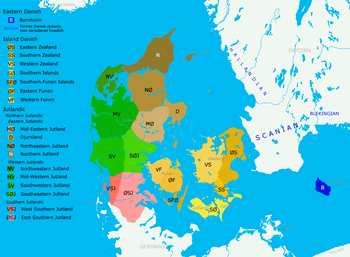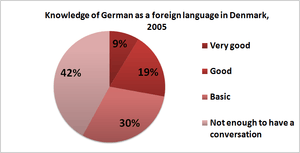Languages of Denmark
| Languages of Kingdom of Denmark [1][2] | |
|---|---|
 Danish dialects | |
| Official languages | Danish |
| Regional languages |
(Officially recognised) Faroese Greenlandic |
| Minority languages | German |
| Main foreign languages |
English (86%) German (47%) Swedish (13%) |
| Sign languages | Danish Sign Language |
| Common keyboard layouts | |

The Kingdom of Denmark has only one official language,[3] Danish, the national language of the Danish people, but there are several minority languages spoken, namely Faroese, German, and Greenlandic.
A large majority (86%)[1] of Danes also speak English as a second language; it is mandatory for Danish students to learn from the first grade in the public elementary schools (Danish: folkeskole), by far the most popular option in the country. In the 1st (or 3rd, depends on the school) grade of folkeskole, a third language option is given, usually German or French. The vast majority pick German (47% of Danes report being able to speak conversational German). The third most widely understood foreign language is Swedish, with 13% of Danes reporting to be able to speak it. [4]
Officially recognized minority languages
Faroese
Faroese, a North Germanic language like Danish, is the primary language of the Faroe Islands, a self-governing territory of the Kingdom. It is also spoken by some Faroese immigrants to mainland Denmark. Faroese is similar to Icelandic, and also the Old Norse language spoken.
German
German is an officially recognized minority language in the former South Jutland County (part of what is now the Region of Southern Denmark), which was part of Imperial Germany prior the Treaty of Versailles.[2] Between 15,000 and 20,000 Ethnic Germans live in South Jutland, of whom roughly 8,000 use either the standard German or the Schleswigsch variety of West Low German in daily communications. Schleswigisch is highly divergent from Standard German and can be quite difficult to understand by Standard German speakers. Outside of South Jutland, the members of St. Peter's Church in Copenhagen use German in their Church, its website, and the school that it runs.[5]
The German minority operates its own system of primary schools with German as the primary language of instruction as well as a system of libraries throughout South Jutland. It also operates a German high school located in Aabenraa (German: Apenrade).
Beside this there are also 28,584 immigrants from Germany in Denmark in 2012.[6]
Greenlandic
Greenlandic is the main language of the 54,000 Greenlanders living in Greenland, which is, like the Faroe Islands, a self-governing territory of the Kingdom. Roughly 7,000 people speak Greenlandic in mainland Denmark. Greenlandic is similar to Inuktitut, and also the Eskimo–Aleut languages spoken in the Arctic North America, and Eastern Siberian area.
See also
References
- 1 2 3 "Europeans and their Languages" (PDF). Ec.europa.eu. Retrieved 6 October 2017.
- 1 2 "Denmark". Ethnologue.com. Retrieved 28 September 2017.
- ↑ "Facts and Statistics". Denmark.dk. Retrieved 16 September 2014.
- ↑ "Special Eurobarometer 386: Europeans and their languages" (PDF). European Commission. Archived from the original (PDF) on 6 January 2016. Retrieved 26 February 2014.
- ↑ "Willkommen Auf Deutsch". Sankt-petri.dk. Retrieved 6 October 2017.
- ↑ "Indvandrere i Danmark : 2012" (PDF). Dst.dk. Retrieved 6 October 2017.
